How to Save Tomato Seeds (and Oddball Varieties)
I have a request! I’d be so delighted if you’d help me locate any seed strain of the OSU P20 blue tomato. (Scroll to the bottom for photos & more details).
Next, the deadline to submit a post about a food or ornamental plant that you’d recommend for How to Find Great Plants is this Friday, January 28th. I’ve noticed that I get the most submissions right before the deadline so I hope a lot of you are still planning to participate in the upcoming issue.
For those of you who haven’t heard, Diana at Kebun Malay-Kadazan Girls is hosting “seed week” from the 22nd – the 29th. I think seed week is more up my alley than shark week, so I’m happy to contribute!

Photo Caption: We thought 'Reisetomate aus Siebenbürgen' was both a fun novelty and a yummy summer treat!
This year I saved seed from dill, achocha, sunberries (Solanum burbankii), garden huckleberries (Solanum melanocerasum), ground cherries (Physalis pruinosa), Zinnia ‘Red Spider,’ papalo, sword beans (Canavalia gladiata), and ‘Reisetomate aus Siebenbürgen’ tomato.
For the most part these were easier for me to save because I was only growing one variety of that species. I rarely save seeds from vegetables that I grow multiple varieties of because it is more challenging to isolate them and prevent unwanted cross-pollination. For example, I know that my ‘Lemon’ cucumber is unlikely to give me seeds that will grow identical fruit the following season since its unprotected flowers occupied the same garden space as the varieties ‘Pearl,’ ‘Arkansas Little Leaf,’ ‘Poona Keera,’ and ‘Kyoto 3-Feet.’ If I planted seeds saved from these cucumbers it would give me fruits with completely unpredictable fruit appearance and taste.
Tomatoes, however, are an exception to that rule… most of the time anyway. The seed-savers FAQ archives on Gardenweb says,
“Tomatoes are generally self-pollinated so there is rarely a chance of cross-breeding. If you save and trade your seeds you might wish to describe your trade offering as “open-pollinated” tomato seeds. That way the trader knows that Mother Nature was solely involved in the fertilization of the flower which produced the tomato that you have saved seeds from.”
Likewise, Jack Rowe’s Seed Saving Handbook says,
“Self-pollinating plants which fertilize themselves before their flowers open (such as tomatoes and beans) are exclusively self-pollinating. These do not need to be isolated under normal circumstances, since by the time their flowers open they will have already pollinated themselves. These plants also benefit from being shaken if they are grown where wind and/or bumblebees cannot shake their flowers naturally.”
Wikipedia explains the science of it,
“Sonication or buzz pollination is a technique used by some bees to release pollen which is more or less firmly held by the anthers, which makes pollination more efficient. The anther of buzz pollinated species of plants is typically tubular, with only an opening at one end, and the pollen is inside – smooth-grained and firmly attached. With self fertile plants such as tomato, wind may be sufficient to shake loose the pollen through pores in the anther and accomplish pollination. Visits by bees may also shake loose some pollen. However, the most efficient pollination is accomplished by a few species who specialize in sonication or buzz pollination.”
I have grown out dozens of packets of home-saved “open-pollinated” tomato seeds and they’ve always come true to type. However, one time I purchased a transplant of ‘Opalka’ from a seed saver that was probably contaminated by cross pollination. It had massive, oxheart shaped fruits with streaked skin like a ‘Speckled Roman.’ I ended up not minding since it tasted fantastic… it probably could have won some giant vegetable awards at the county fair, too.
Speaking of weird tomatoes, I think ‘Reisetomate aus Siebenbürgen’ must be the epitome of oddball heirlooms with a rich flavor worthy of the space in your garden. I wrote about our experiences with it here if you’d like more information.
Since my original source only sent me 5 seeds it was high on my priorities as home-saved variety.This isn’t difficult, but it’s also not as simple as stuffing some dried seed heads in an envelope.
Saved tomato seeds require a small amount of processing once you’ve harvested them — a fermentation method that is supposed to improve viability and kill seed-borne diseases. Here’s how you do it:
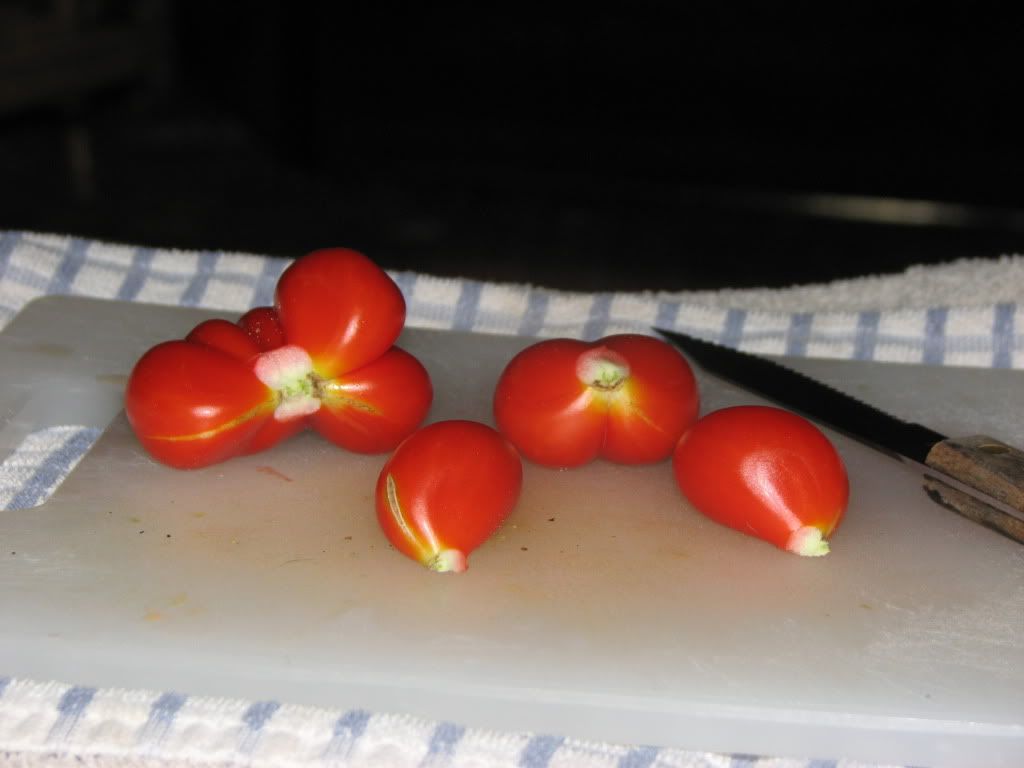
Photo Caption: 'Reisetomate Aus Siebenbürgen' fruits pull apart into little sections, which is why it translates to "traveling tomato." You can pack it for a bag lunch and never need a knife.
First, save the best tomatoes from all of your healthy, highest quality plants (of that one variety). The more plants you have, the more genetic diversity ends up in your saved seeds. Fortunately, the seeds are ripe when the tomato is ready to eat so you can plan to make salsa or some other recipe from the remaining flesh when you finish.
Tomato seeds don’t require cold stratification (a period of cold before germinating) so to keep next year’s seeds from germinating too soon, the gel coating the seeds developed growth inhibitors. When that gel coating rots away the seed becomes free to germinate. Fermenting the seeds at home mimics Mother Nature and prepares them for the following season.
You’ll need to collect the gel and seeds from your tomatoes. Regular, round tomatoes are a little easier to save seeds from since you can simply slice them in half instead of pulling apart the protuberances and then slicing them in half. I tried slicing the whole Reisetomates in half but their chambers were often unconnected and I couldn’t squeeze out the gel. If it won’t squeeze out like a lemon half, you can also scoop it out with a spoon. Meaty beefsteak types are a little more challenging, too.

Photo Caption: Reusable containers or glass canning jars are excellent tomato seed fermenters -- especially if you saved the lid.
But your goal is just to squeeze the gel and seeds into one container per variety. If you’re saving multiple containers of seeds be sure to label them with the variety name. Otherwise you’ll be playing eeny meeny miny moe when it comes time to package them.
The mixture of gel, juice, and seeds should have a thin, soupy consistency — the seeds should be floating in liquid. You can add some water to your container if it is mostly solids.
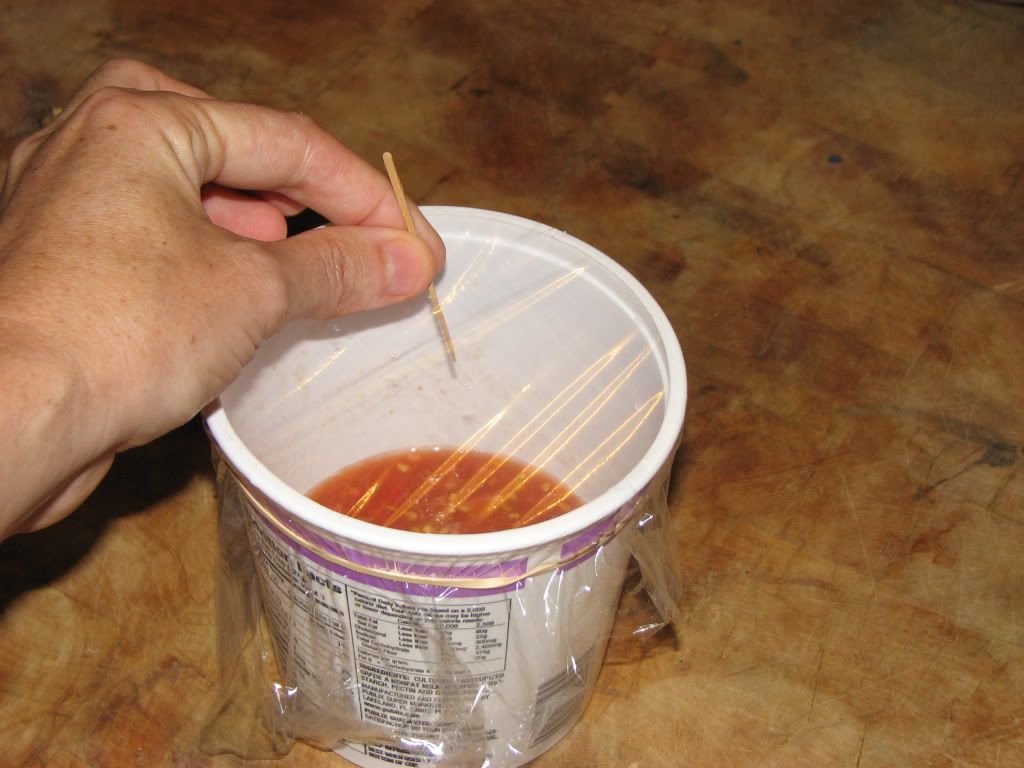
Photo Caption: I was worried my family would complain about the smell so I went with a conventional plastic cover and small ventilation holes. If you can find the lid to your reusable container, just put a small hole in it.
Fruit flies can be a problem so you’ll need to cover the container and make sure it has some ventilation. A cloth or paper towel with a rubber band around it will work well. Then, put it in a warm place such as on top of the refrigerator, on a water heater, or next to a sunny window (I put mine on top of a heated aquarium).
Once a day you should stir the mix to help separate the seeds. Good, viable seeds will sink to the bottom whereas most the pulp rises to the top. After about 2 – 4 days a fungal film should completely cover the surface of the liquid. If you used a clear container, you may also see air bubbles rising up through the fluid to the surface.
When this happens it is time to prepare your seeds for drying. Don’t procrastinate! I’ve had friends who left their seeds to ferment too long and they actually germinated in the stinky liquid. Also, this project is not potpourri — the sooner you eliminate it from your home, the happier your nose will be. (But if you put it in an out-of-the-way place you won’t notice the smell except at stirring time).
Some people leave the fungus through the rinse cycle but I gently scoop the film off and discard it in my compost bin. It’s okay to throw out the “floater” seeds that are caught in the white mold — supposedly they won’t germinate, anyway. I do, but it has more to do with the fact that slime handling gives me the heebie jeebies. Once the mold is gone I pour the seeds into a sieve and rinse them until the pulp disappears.

Photo Caption: You may need to gently rub the seeds to free them from the last bits of pulp, but don't do it too hard or you may grate them with your strainer.
Once the seeds are rinsed I spread them out on parchment or waxed paper that I place in my bathtub. I leave them there to drain for about an hour before moving the parchment to a regular table.
Trying to spread wet, furry seeds into a single layer is about as challenging as stretching out pizza dough for the first time. If they persist in sticking together just come back a couple hours later and try again. They need to air out for at least a week in open air, stirring occasionally. The seeds are finished when none of them stick together (you’ll have to gently crumble some of them apart), they slide freely across the paper, and they feel completely dry. This should take no more than 2 weeks unless you have an unusually humid environment.
Now you can put them in a seed packet, label it, and store it for the following season.
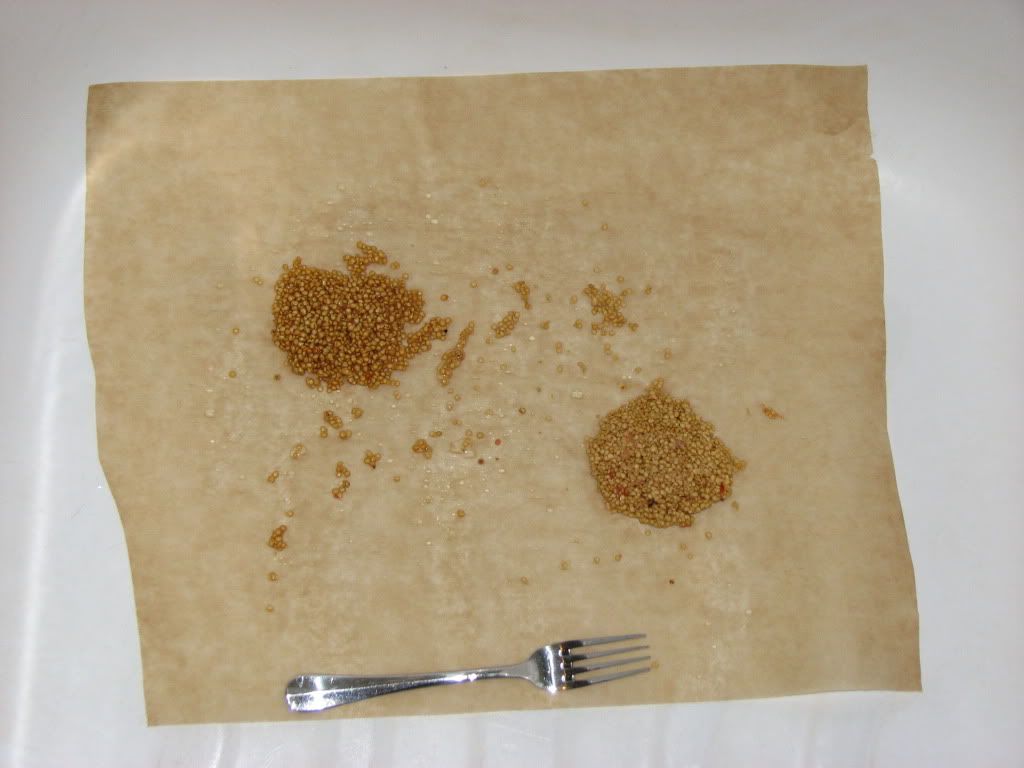
Photo Caption: I saved a lot of this variety because I wanted to be able to trade generous packets and offer transplants to friends.
I’ve composted parchment paper after use but I just read that it is impregnated with silicone… not a natural wax as I had assumed. This year I think I will try drying my seeds on a flat cloth napkin. Does anyone have experience with this? It seems like you could easily peel seeds off of a fabric napkin if they happened to stick.
If your seeds have any residual dampness and you store them in airtight plastic envelopes they will mildew and ruin. However, it isn’t safe to use heat to speed the drying process (it can kill the embryos). Tomato seeds (stored properly) are viable for 8 – 12 years or more.
I like to store mine in paper packets because it gives you some leeway on the moisture and mold problem. Plus paper is fun to decorate! I’ve been making a lot of stamps lately so I decided to carve one to use for labeling my ‘Reisetomate Aus Siebenbürgen’ packets.
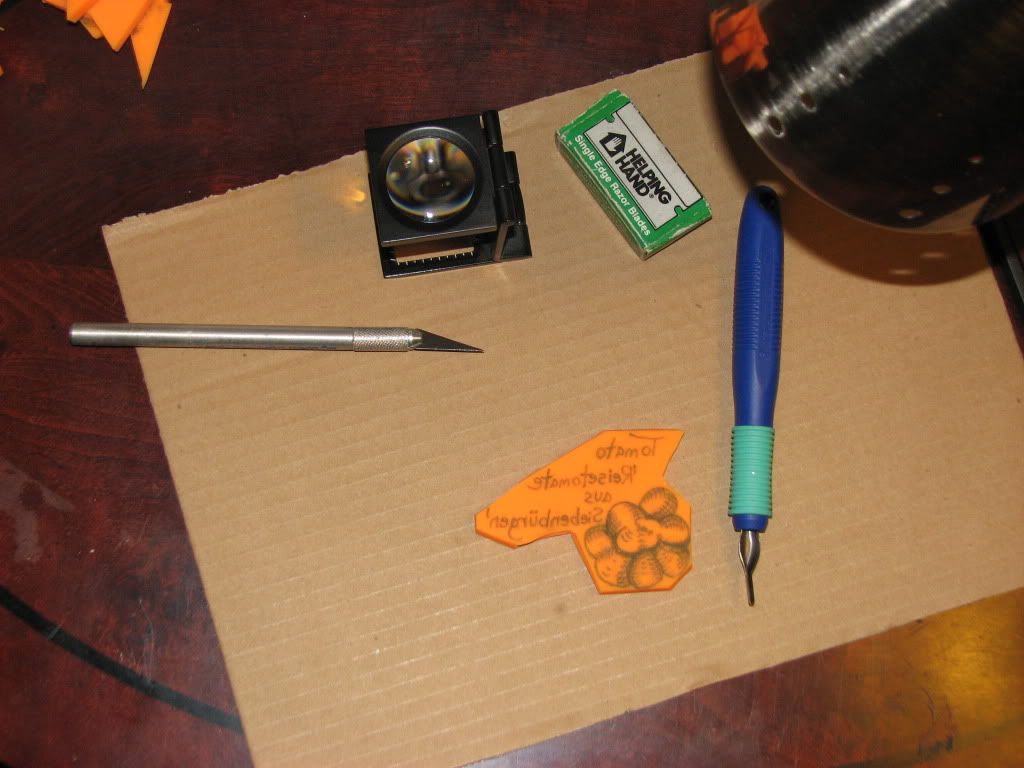
Photo Caption: I draw the image on my stamp medium and carve the fine details by looking through a linen loop magnifier.
I get my supplies from Stampeaz.com but you can also get (pricier) stamp carving medium from craft supply stores. Once I’ve transferred my image to the stamp medium (the lettering has to be carved in mirror reverse) I use an X-Acto knife and a small gouge to remove the negative space.

Photo Caption: I carved "Appalachian Feet" and the year as separate stamps so I could use them with other seed varieties. Here they all are on 3 different seed packets. My mom thought my lumpy 'Reisetomate aus Siebenbürgen' drawing looked like a flower, but I think it is close enough.
For this project I made 3 stamps and tried a few different options for applying them to the coin envelopes I use as seed packets. You can also use recycled paper to fold your own envelopes:
- Making a Paper Envelope @ ICPS Seed Bank
- Origami Seed Packets @ The Cheap Vegetable Gardener
- Origami for Seed Savers @ Hayefield
- Origami Seed Packet @ Downsizer.net
- Origami Envelope @ Gillian Crackers
- Seed Envelopes @ Blossom Swap
- Flower Seed Packets @ Squidoo
- Seed Envelopes @ eHow
- Seed Envelope Patterns @ Caustic Musings
Once you’ve saved seeds you may want to try exchanging them at a local seed swap or an online trading site. GardenWeb and the Seed Savers Exchange are the most popular ones I know of.
Which brings me to the seed I currently want…
These tomatoes are from research and (non-GMO) breeding done by Oregon State University. I understand there are some different strains now but they come from a variety referred to as P20. Some people seem to love the flavor and others don’t… I’m not sure if that’s because the tomatoes are variable or because human palates are variable. Maybe a little of both.
*Edit* Thanks to Robin from The Gardener of Eden for helping me find some!
So, happy “Seed Week” everyone and don’t forget to submit your blog post for How to Find Great Plants! The deadline is this Friday (it will be published on the following Monday). Remember you can reuse a post you’ve already written, here’s the link:
34 thoughts on “How to Save Tomato Seeds (and Oddball Varieties)”
Comments are closed.

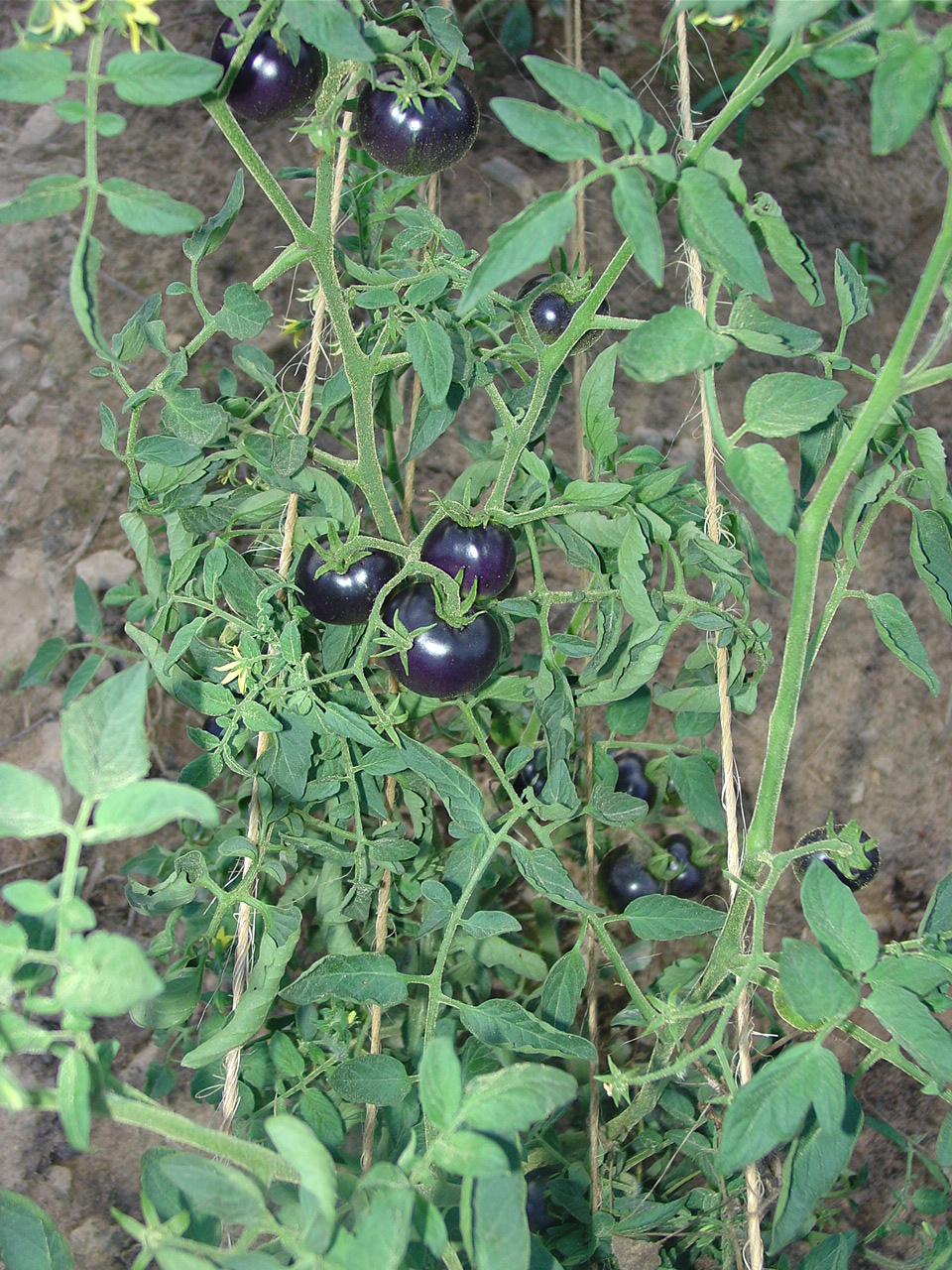

Robin - January 25, 2011 6:21 pm
they have those seeds here http://solanaseeds.netfirms.com/welcome.html
.-= Robin´s last blog ..The Cold Frames before the Storm =-.
Sustainahillbilly
Twitter: appalachianfeet
- January 26, 2011 8:37 am
Thanks, you totally made my day!
.-= Sustainahillbilly´s last blog ..How to Save Tomato Seeds and Oddball Varieties =-.
Donna - January 25, 2011 8:23 pm
I enjoyed your really informative post. Plus you showed the weirdest looking tomatoes I have ever seen. I never have saved their seeds, but with the ease that they come up the following year, I never realized the extent of the proper process for saving them.
.-= Donna´s last blog ..Schematic Design – Process of Design =-.
Sustainahillbilly
Twitter: appalachianfeet
- January 26, 2011 8:41 am
Haha — yeah, they do come up all over the place where they’ve fallen. The thing is, that means Mother Nature did the fermenting method for you right out in the garden. You know how those nasty, rotting tomatoes get fungal froth at their cuts? It’s the exact same process.
Diana - January 25, 2011 10:04 pm
Kids would like to grow those oddball varieties ( Mom Too ;-))I have not save any tomato seeds before but hopefully if time permit I will attempt to save them. Your home-made seed-envelope look so cool. No wonder you want to find the blue tomato seeds, I too would like to grow them. Thank you for sharing Eliza!
.-= Diana´s last blog ..Viola Life Cycle Seed Week & Seeds Give-away =-.
Sustainahillbilly
Twitter: appalachianfeet
- January 26, 2011 8:47 am
Yeah, I bet your kids would love these! I’d send you some but I’m not sure customs allows it. I hope you’re able to save your own tomato seeds this year (and it isn’t all that time consuming — the part that takes the longest is squeezing seeds into a container).
Elaine - January 25, 2011 11:08 pm
Another great and informative post, Eliza! You are incredibly talented – your carved stamp and your seed packets are lovely! I learn something new every time I stop by and that is why I have awarded you a “Stylish Blogger Award” via my blog. Happy Seed Saving!
Happy Seed Saving!
.-= Elaine´s last blog ..Stylish Blogger Award =-.
Sustainahillbilly
Twitter: appalachianfeet
- January 26, 2011 8:48 am
Thanks so much for thinking of me, and congratulations on your win of the award, too.
p3chandan - January 26, 2011 4:21 am
Thanks Eliza for the useful informations to process the tomato seeds as Im saving my own tomato seeds for the first time.
.-= p3chandan´s last blog ..Wordless Wednesday – Stolen Bites =-.
Sustainahillbilly
Twitter: appalachianfeet
- January 26, 2011 8:49 am
Great! I hope it goes well.
fer
Twitter: mygardeninjapan
- January 26, 2011 7:55 am
Very good idea, I want to try saving some tomato seeds this season.
Also, your stamps look great!
.-= fer´s last blog ..How to set a plant in a container =-.
Sustainahillbilly
Twitter: appalachianfeet
- January 26, 2011 8:57 am
Thanks! I hope your seed saving goes well.
.-= Sustainahillbilly´s last blog ..How to Save Tomato Seeds and Oddball Varieties =-.
Patricia - January 26, 2011 11:16 am
Wonderful, comprehensive post. I remember the first year I saved tomato seeds “correctly.” Such a sense of satisfaction I had when they were all dried and looked so pristine. They germinated well the next spring. I agree with you that the hardest part is drying them. I have tried wax paper, cloth, paper towel and they still stick to the item. Mine end up in a recycled glass jar. I am impressed with the effort to make your artistic envelopes. And, I have never seen a blue tomato! Thanks for stopping by my blog and leaving a comment!
.-= Patricia´s last blog ..I Am a Citizen – Using the Public Library =-.
Sustainahillbilly
Twitter: appalachianfeet
- January 27, 2011 2:14 pm
I just saw a photo of someone drying them on a metal screen and nearly slapped my head with a corresponding, “duh!”
I agree that the first time doing the fermenting process is immensely satisfying. I love when seemingly daunting things turn out to be incredibly easy. You still feel like you accomplished something difficult.
Sustainahillbilly´s last blog post ..How to Save Tomato Seeds and Oddball Varieties
Lrong - January 26, 2011 7:47 pm
I have never seen tomatoes with such interesting shapes…
Very catchy post!
Sustainahillbilly
Twitter: appalachianfeet
- January 27, 2011 6:44 pm
Thanks! They certainly catch the eye.
Sustainahillbilly´s last blog post ..How to Create a Window Farm Real Things Thursdays
Carolflowerhill
Twitter: flora
- January 26, 2011 8:50 pm
Very impressive Eliza!! Wow! Now can you imagine not being allowed to plant those seeds. Since it is seed week . . . a perfect time to continue fighting GMO Alfalfa . . . Seeds are so important!!
Sustainahillbilly
Twitter: appalachianfeet
- January 27, 2011 6:45 pm
I absolutely agree! Seeds and other living things should not be restricted with trademarks and copyrights. Nor should their genetic integrity be threatened by the neighbor’s field of pollen.
Alistair - January 27, 2011 8:54 am
Eliza, that is what I call an informative post. Oh by the way directly under this box is a message in red text It basically says comments are no longer supported and your plugin needs updating. Well any way, funny shaped tomatoes, the Spaniards always used to see we Brits were obsessed with tomatoes being perfect, always reminds me when I had the shop the wholesaler would have boxes of misshaped tomatoes which they called domestics, we were able to sell them at 5p the pound, yes they bought them then.
Sustainahillbilly
Twitter: appalachianfeet
- January 27, 2011 6:47 pm
Oops! Thanks for alerting me, I updated the plugin so it works now.
My mom isn’t a fan of pleated tomatoes or other strange shapes — she wants them round and perfect. I’m more of an equal opportunity tomato lover. If it’s a tomato, I love it.
Sustainahillbilly´s last blog post ..How to Create a Window Farm Real Things Thursdays
Mike - January 27, 2011 9:04 am
I really enjoyed reading this post and loved seeing your Reisetomate aus Siebenbürgen tomato and hearing about the P20…both quite fascinating. fpr another possible source for an OSU Blue Tomato you might check here. That was an excellent tutorial on tomato seed saving, thanks for sharing.:)
If the above link did not work here it is again –
http://homegrowngoodness.blogspot.com/2010/12/face-of-earth-seed-bazzar-2011-public.html
Sustainahillbilly
Twitter: appalachianfeet
- January 27, 2011 6:59 pm
Thanks for the new seed directory… my garden is going to bust this year! Love your blog.
Sustainahillbilly´s last blog post ..How to Create a Window Farm Real Things Thursdays
Janet - January 27, 2011 9:15 am
Glad you found a source for the Blue Tomatoes Eliza. What fun! Our next trip up to Greenville we need to plot out our route to the Peace Center…have a concert at the end of Feb. Thought of you when we were up there yesterday.
Sustainahillbilly
Twitter: appalachianfeet
- January 27, 2011 7:00 pm
What’s the date of the concert?
Janet - January 27, 2011 10:40 pm
Feb. 26th– we are seeing John Prine and Old Crow Medicine Show. So excited!
Janet´s last blog post ..Tuesdays Trees- Baldcypress
lifeshighway
Twitter: lifeshighway
- January 27, 2011 11:13 am
I am so out of my league here.
But I will say, I would love to taste a blue tomato.
Sustainahillbilly
Twitter: appalachianfeet
- January 27, 2011 7:01 pm
Hahaha!
I tried shipping fresh tomatoes to a friend in Oklahoma once and it was disastrous. I’ll let you know if they’re any good!
Greenearth
Twitter: anewgreenearth
- January 27, 2011 3:31 pm
What a great post. Have given it a tweet and shared with family on Facebook.
Greenearth´s last blog post ..Community Garden Survival Foods
Sustainahillbilly
Twitter: appalachianfeet
- January 27, 2011 7:01 pm
Thanks!
Sustainahillbilly´s last blog post ..How to Create a Window Farm Real Things Thursdays
Ellada - January 28, 2011 2:42 am
Hi, I have some OZU blue, if you want, I can send you some for free, of course.
And if you want more you can go in my blog and look at my collection.
http://auxplaisirsdujardin-ellada.blogspot.com/2010/11/les-graines-seeds.html
Ellada´s last blog post ..Les grainesΟι σπόροιThe seeds
Sustainahillbilly
Twitter: appalachianfeet
- February 2, 2011 1:25 pm
Awesome! I am planning to go through the seed trade emails I’ve received tonight and I’d love to receive the OZU blue that you have. I’ll get back to you this evening.
I’ll get back to you this evening.
Sustainahillbilly´s last blog post ..How to Find Great Plants- Issue 3
Pingback: How to Trade Seeds with Me | Appalachian Feet
Brian - February 14, 2011 12:18 pm
I have blue tomato seeds, LOTs of them. I saved every seed I possibly could from 2 seperate varities / sources. They are fun to grow, but taste like a commercial store bought tomatoes, awful, compaired to a home grown tomato. There very productive, 1-2″ fruit..
I also have a limited amount of a heirloom we crossed that have the best taste of any tomato I’ve ever grown.
Always willing to trade for different varities.
Sustainahillbilly
Twitter: appalachianfeet
- February 20, 2011 6:45 pm
Hi! I’m definitely interested in trading, did you see my seed list over at GardenWeb? Let me know what you’d like in exchange! I’d love to try the homemade heirloom as well as the blue tomato seeds.
Sustainahillbilly´s last blog post ..How to Help Bats Succumbing to White Nose Syndrome